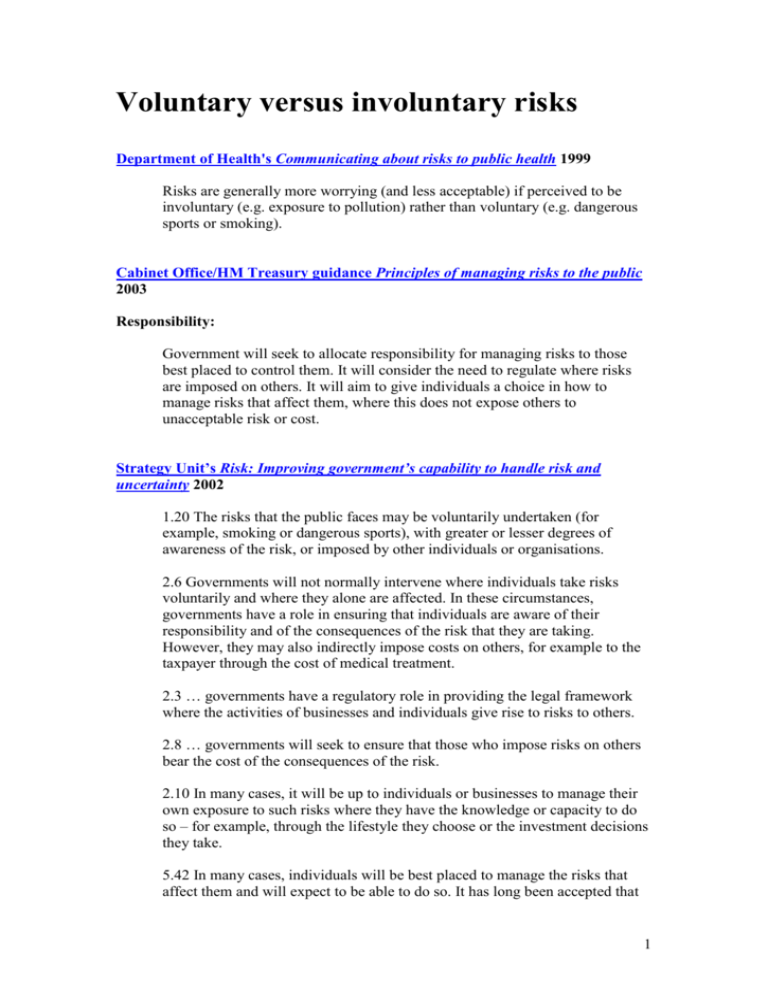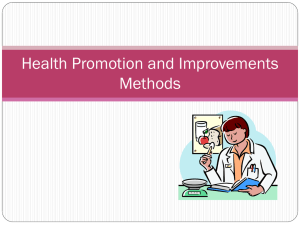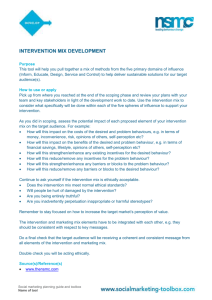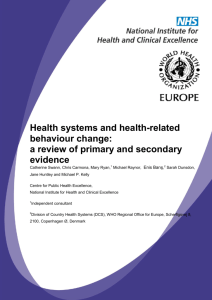Voluntary vs. involuntary risks
advertisement

Voluntary versus involuntary risks Department of Health's Communicating about risks to public health 1999 Risks are generally more worrying (and less acceptable) if perceived to be involuntary (e.g. exposure to pollution) rather than voluntary (e.g. dangerous sports or smoking). Cabinet Office/HM Treasury guidance Principles of managing risks to the public 2003 Responsibility: Government will seek to allocate responsibility for managing risks to those best placed to control them. It will consider the need to regulate where risks are imposed on others. It will aim to give individuals a choice in how to manage risks that affect them, where this does not expose others to unacceptable risk or cost. Strategy Unit’s Risk: Improving government’s capability to handle risk and uncertainty 2002 1.20 The risks that the public faces may be voluntarily undertaken (for example, smoking or dangerous sports), with greater or lesser degrees of awareness of the risk, or imposed by other individuals or organisations. 2.6 Governments will not normally intervene where individuals take risks voluntarily and where they alone are affected. In these circumstances, governments have a role in ensuring that individuals are aware of their responsibility and of the consequences of the risk that they are taking. However, they may also indirectly impose costs on others, for example to the taxpayer through the cost of medical treatment. 2.3 … governments have a regulatory role in providing the legal framework where the activities of businesses and individuals give rise to risks to others. 2.8 … governments will seek to ensure that those who impose risks on others bear the cost of the consequences of the risk. 2.10 In many cases, it will be up to individuals or businesses to manage their own exposure to such risks where they have the knowledge or capacity to do so – for example, through the lifestyle they choose or the investment decisions they take. 5.42 In many cases, individuals will be best placed to manage the risks that affect them and will expect to be able to do so. It has long been accepted that 1 individuals are more likely to tolerate a risk when they perceive that they are able to control their own exposure to it. 5.43 Where Departments have policy responsibility for handling risks that directly affect the public, they should consider the scope for increasing the availability of choice to individuals, supported by relevant information and advice. Annex 4: key factors when looking at judgements of risk Degree of control, and is the risk voluntary or imposed: In general, people are more likely to accept the consequences of risks that they take willingly, and are therefore within their control, than risks over which they have no choice. Saving Lives: Our Healthier Nation 1999 1.26 People are responsible for their own actions in health as in other areas. But the decisions people take over their health are more likely to result in better health and a healthier life if they have the opportunity to make informed decisions. 1.29 For people to make such decisions against the background of such powerful determinants, they need to make informed decisions. Such decisions must be based on information about the risks involved in a range of activities, practices and products. People cannot and should not be pressured into responsibility. We do not believe in the old nanny-state approach. But there is a powerful role for Government in making clear the nature and scale of risk, and in some cases, taking protective action in the light of it. 1.33 Individuals are central to our new vision for better health. People need to take responsibility for their own health - and many are doing so. There is a new and clear realisation that individuals can improve their health, by what they do and the actions they take. 1.37 Government will play its part by creating the right conditions for individuals to make healthy decisions. 1.41 ... tackling smoking depends on relieving the conditions - social stress, unemployment, poor education, crime, vandalism - which lead far more people in disadvantaged communities to smoke than in other sections of the community. 3.25 it is the role of the Government to provide information about risk. But in most cases it is for the individual to decide whether to take the risk. And there is also a balance between risk and personal freedom. Some people enjoy 2 pursuing outdoor sports which others would consider too dangerous to undertake. As long as people are aware of the risk which they are taking, it is their decision whether to put themselves at risk. Choosing Health White Paper 2004 Foreword by Tony Blair: Changes need to be based on choices, not direction. We are clear that Government cannot – and should not – pretend it can ‘make’ the population healthy. But it can – and should – support people in making better choices for their health and the health of their families. It is for people to make the healthy choice if they wish to. Preface by John Reid, Health Secretary: First, people told us that they want to take responsibility for their own health. They were clear that many choices they made – such as what to eat or drink, whether to smoke, whether to have sex and what contraception to use – were very personal issues. People do not want Government, or anyone else, to make these decisions for them. Second, what they did expect was that the Government would support them in making these choices. They wanted clear and credible information, and where they wanted to make a change and found it hard to make a healthy choice they expected to be provided with support in doing so – whether directly or through changes in the environment around them – so that it is easier to ‘do the right thing’. Choosing health sets out key principles for that support. Our starting point is informed choice. People cannot be instructed to follow a healthy lifestyle in a democratic society. Health improvement depends upon people’s motivation and their willingness to act on it. While we respect individuals’ rights to make their own choices, we need to respond to public concern that some people’s choices can cause a nuisance and have a damaging impact on other people’s health. We need to strike the right balance between allowing people to decide their own actions, while not allowing those actions to unduly inconvenience or damage the health of others. Moreover, in the case of children there is a greater case and requirement for protection. Children need a protected environment as they learn about making lifestyle decisions that impact on their health. Executive summary: Introduction: 7. [Society] needs policies and approaches which reflect the realities of people’s lives today. That means an approach which respects the freedom of individual choice in a diverse, open and more questioning society; which 3 recognises the realities of the impact of the consumer society on those choices; which addresses the fact that too many people and groups have been left behind or ignored in the past; Underpinning principles: 9. (1) Informed choice. People want to be able to make their own decisions about choices that impact on their health and to have credible and trustworthy information to help them do so. They expect the Government to provide support by helping to create the right environment. However, this principle is subject to two qualifications. First, people believe that we need to exercise a special responsibility for children who are too young to make informed choices themselves. Second, people agree that we need special arrangements for those cases where one person’s choice may cause harm or nuisance to another, such as exposure to second hand smoke. We need to balance rights and responsibilities, in ways that protect health. 10. Overarching priorities: Reducing the numbers of people who smoke; Reducing obesity and improving diet and nutrition; Encouraging and supporting sensible drinking; Derek Wanless Report: Securing Good Health for the Whole Population [2004] 7.3 Individuals are, and must remain, primarily responsible for decisions about their and their children’s personal health and lifestyle. Individuals must be free to make their own choices about their own lifestyles. 7.4 If government or other bodies do intervene, it is essential that social welfare is improved and that personal freedoms are respected. 7.43 Individuals are primarily responsible for their own health and lifestyles. As discussed in the analysis above, they are generally best able to make these decisions as they know more about their personal preferences and situation and generally are the best judge of their own health and happiness; and any intervention into an individual’s lifestyle can raise legitimate questions of personal freedom. 7.29 Influencing and, over time, changing social attitudes to health and lifestyles is likely to be much more effective in the long run than a punitive approach that does not also aim for a change in attitude. Laws and regulations not accompanied by public support incur high enforcement costs, and could jeopardise the development of a consensus for future public health measures. 7.59 It is important that any government intervention is well managed, to protect against an inappropriate infringement of liberty or unintended consequences. To assist in the development of targeted interventions that 4 increase both health and welfare, the following principles are suggested for adoption by government: 5. The right of the individual to choose their own lifestyle must be balanced against any adverse impacts those choices have on the quality of life of others. 8.7 Where regulation is enacted, it is important that it is both efficient and respects civil liberties. 8.13 In addition to public health campaigns, health professionals have a role in ensuring that citizens are more fully informed about ... alternative, less harmful, products and lifestyle choices they could make. 8.17 Taxes should therefore provide incentives for consumers either to lower consumption or to switch to less damaging products, thereby reducing demand for harmful goods to the socially optimal level. Furthermore, the suppliers of harmful products will have an incentive to produce less damaging goods, either through switching product mixes or investing in new technology. Limits to Government intervention: 8.42 Interventions to improve public health have the potential to reduce significantly personal freedoms. This is most clear when government acts explicitly to prevent or restrict individuals from behaving in certain ways, or from consuming particular goods. 8.43 In general, if the freedom to be curtailed or limited is a significant one and valued highly by the individual, the state would need strong reasons to impose its will over the individual on public health grounds. Usually, there should at least be a strong consensus, preferably public but certainly professional, that the public health measure is necessary to prevent harm to others. Government can of course legitimately intervene when one’s freedom to act would infringe human rights for example, a person with a highly infectious disease may need to be quarantined without consent. In other cases, however, the mere fact of social or professional consensus may not provide sufficient justification for action. 8.44 Ideally, individual consent provides the strongest foundation for government action. However, in cases where it is only the individual's health that is at issue, the question of intervention without consent poses challenges. Nevertheless, there are examples where such measures have been enacted and have become accepted (see box 8.6 on safety belts). First, individuals may already prefer not to be free to choose, and may accept restrictions. Second, they may come to accept the reasons behind the restrictions and no longer see them as an imposition. Nevertheless, it is important to recognise that measures should be justifiable in the public interest and to individuals as a reasonable restriction of their freedom. 5 Prime Minister's Strategy Unit’s Personal Responsibility and Changing Behaviour 2004 Executive summary: Consideration is given to how government acting as a more effective ‘persuader’ can be squared with an agenda of enhanced personal responsibility – helping people to help themselves. … the limits of top-down policies to change behaviour are highlighted. In some cases, the application of alternative approaches might allow government to relax more punitive and rigid approaches to behaviour change. 1. Introduction: … the eventual aim is to entrench a habit of personal responsibility and restraint, and a self-sustaining social norm. 1.1 Government can’t do it alone: Health outcomes rest heavily on the lifestyle and behaviour of citizens (diet, exercise, smoking, drinking) and only modestly on the quality of secondary health care; Crime and antisocial behaviour is at least as strongly affected by the values and behaviour of individuals and communities as by the activities of the police and criminal justice system; Education. Research has suggested that more variability in educational outcomes is explained by what happens in the home than in the school. 1.2 For many traditions of social and political thought greater personal responsibility is a good in itself: it enables society to function with a less coercive state and judicial system; it enables public goods to be provided with a lower tax burden; the exercise of responsibility strengthens individual character and moral capacity; and greater personal responsibility – in terms of restraint and support for others – enhances the quality of life of the whole community. 1.3 A further key argument is cost-effectiveness. Detailed cost-benefit analyses in health, crime and education have shown that behaviour-based interventions can be very much more cost-effective than traditional service delivery. For example, smoking cessation programmes deliver around ten-fold more quality-adjusted life years per pound than expenditure on drugs to reduce cholesterol. 6 1.4 Establishing the division of responsibility between individual, community and state. Assessments of causal responsibility: Generally speaking, people tend to assign ‘moral’ or ‘fair’ responsibility on the basis of who, or what, was the cause. Hence we seek compensation from the reckless individual or organisation that causes a major accident, but think it wrong for an individual to have to pay for treatment for an illness resulting from factors beyond their control, such as their genes or pollution. Similarly, more moral responsibility is assigned for educational choices to eighteen year olds than five year olds, on the basis that an eighteen year old has far more knowledge, control and ability to predict the consequences of their life choices. This has been characterised as a presumption that individuals should take responsibility for their ‘knowingly taken life-choices’ (for good or bad) while the state or community should seek to attenuate ‘bruteluck’ effects, such as result from family social background. 2.1 All modern societies suffer the consequences of prohibitions that are only partially effective – for example, against hard drug use. Clearly laws on their own have only limited efficacy where other powerful drivers of behaviour are involved. There is a mature and growing body of knowledge in psychology offering a more sophisticated approach to behaviour and behaviour change, but that remains largely untapped by many policymakers. 4.2 …interventions to curb drug use have been popularly supported despite relatively modest evidence of significant impact. …probably the most simple and important point is that consistency matters – behaviour is most powerfully shaped when all the influences on a young person, from infancy to adulthood, point in the same direction. An over-arching logic: helping people help themselves 3.5 ... a key role of the state is to encourage in us behaviour that is in our own best interests. ... sometimes everyone engages in behaviours that they may regret or that do them harm, or harm to those around them. There is a potential tension between, on the one hand, an agenda of encouraging personal responsibility and, on the other hand, of the shaping of the determinants of personal behaviour by the state. How can this be resolved? One solution is to recognise that policy can have twin goals which operate together - policy must at once empower and give choices, but at the same time policy should set the default to be in the best interests of individuals and the wider public interest. To be effective, this twin approach needs to be built around a sense of partnership between state and individual. Hence in employment, while individuals are not ultimately forced to work, the strong 7 default pressures are that they will. In education, young people are not forced to stay on in school and acquire qualifications, but the default pressures are that this is what they do. And in health, governments do not ban unhealthy foods or smoking, but seek to refashion the behavioural pressures towards healthier choices. 8








